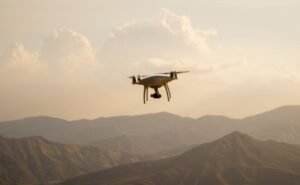AI Creating Deepfakes
The rise of artificial intelligence (AI) has brought both tremendous advancements and new challenges. One such challenge is the emergence of deepfake technology, powered by AI algorithms that can manipulate or fabricate digital content, including images and videos, so convincingly that it becomes difficult to distinguish from real footage. Deepfakes have gained popularity in recent years and have raised concerns about their potential misuse.
Key Takeaways:
- AI-powered deepfake technology can manipulate or fabricate digital content, such as images and videos, with alarming realism.
- Deepfakes have gained popularity and have raised concerns about potential misuse, including misinformation, identity theft, and privacy violations.
- Recognizing and combatting deepfakes require the development of advanced detection techniques and public awareness.
Deepfakes are created using machine learning algorithms, particularly generative adversarial networks (GANs), which can analyze and replicate patterns from existing data sets to generate realistic images and videos. **These algorithms work by creating a “generator” network that produces the fake content and a “discriminator” network that tries to distinguish between real and fake content**. The generator network gradually improves its ability to produce convincing deepfakes, and the discriminator network becomes increasingly challenged to differentiate between the real and fabricated content.
**One interesting aspect of deepfake technology is that it not only allows for face swapping but can also alter facial expressions and movements**, making it even more difficult to detect manipulated content. The potential applications of deepfakes range from entertainment and creative expression to more malicious uses, such as spreading misinformation, defaming individuals, or influencing public opinion.
The Impact of Deepfakes
Deepfakes have significant implications for various aspects of society, including politics, journalism, and personal privacy. Here are some important points to consider:
- **Deepfakes can be used for political disinformation campaigns**, posing a threat to the integrity and trustworthiness of democratic processes.
- **Journalists face challenges in verifying the authenticity of content**, and deepfakes could be used to spread false information or manipulate public perception.
- **Individuals may fall victim to identity theft or impersonation**, as deepfakes can be used to create fraudulent videos or images for malicious purposes.
Detection and Prevention
As deepfakes become more sophisticated, **detecting and combatting them requires advanced techniques**. Ongoing research is focused on developing algorithms and tools to identify and debunk deepfakes. Some methods used for detection include:
- Analysis of facial anomalies, such as inconsistent blinking or unnatural movement, which may indicate a fake video.
- Comparison of audio characteristics and lip-sync accuracy to assess the authenticity of speech.
- Use of machine learning algorithms to detect patterns and artifacts specific to deepfake generation.
Despite these efforts, the arms race between deepfake creators and detection systems continues. **The constant evolution of deepfake technology necessitates vigilance, public awareness, and continuous refinement of detection methods**.
Data Points
| Year | Reported Incidents |
|---|---|
| 2017 | ~7,000 |
| 2018 | ~14,000 |
| 2019 | ~48,000 |
| Misuse Category | Examples |
|---|---|
| Social Manipulation | Political disinformation, celebrity scandals |
| Identity Theft | Fraudulent impersonations, revenge porn |
| Privacy Violations | Non-consensual explicit content, blackmail |
| Method | Accuracy |
|---|---|
| Facial Anomaly Analysis | 78% |
| Audio Comparison | 81% |
| Machine Learning Algorithms | 92% |
It is crucial to stay cautious in the face of ever-evolving deepfake technology. **Protecting personal information, verifying the authenticity of online content, and raising awareness about the existence and potential dangers of deepfakes are essential steps in mitigating the risks**. By staying informed and taking necessary precautions, we can navigate the digital landscape with greater confidence and security.

Common Misconceptions
Misconception 1: AI Creating Deepfakes is Perfectly Accurate
One of the common misconceptions about AI creating deepfakes is that the results are flawlessly accurate and indistinguishable from reality. However, this is far from the truth. While AI algorithms have improved significantly in generating realistic deepfakes, they still have limitations and can produce errors and inconsistencies.
- AI-generated deepfakes can have visual artifacts that give away their authenticity.
- Facial expressions and lip-syncing may not always match perfectly in deepfakes.
- Creating deepfakes of high-profile individuals can be more challenging due to limited training data available.
Misconception 2: AI Creating Deepfakes is Exclusively Harmful
Another common misconception is that AI creating deepfakes is purely a harmful technology used for creating fake videos with malicious intent. While it is true that deepfakes have the potential to be misused for spreading misinformation, they also serve various positive purposes.
- AI-based deepfake technology can be used in the entertainment industry for creating realistic special effects.
- Deepfakes can facilitate historical recreations by bringing past events and personalities to life.
- Education and awareness campaigns can utilize deepfakes to simulate scenarios and communicate important messages.
Misconception 3: AI Creating Deepfakes Requires Extensive Technical Knowledge
Many people believe that creating deepfakes using AI requires advanced technical skills and expertise. While some level of technical knowledge is indeed necessary, developing deepfakes has become more accessible to non-experts due to the availability of user-friendly tools and platforms.
- AI-powered applications and websites have simplified the process of creating deepfakes with user-friendly interfaces.
- Tutorials and online resources provide step-by-step guidance for beginners interested in creating deepfakes.
- Pre-trained models and datasets are readily available, reducing the need for extensive technical know-how.
Misconception 4: AI Creating Deepfakes is Impossible to Detect
There is a misconception that AI-generated deepfakes are impossible to detect, making it challenging to distinguish between real and fake videos. While it is true that deepfake detection is an ongoing challenge, researchers and technology experts are actively working on developing tools and techniques to identify manipulated content.
- Advancements in AI algorithms have led to the development of deepfake detection models for identifying suspicious videos.
- Forensic analysis techniques can be employed to examine anomalies and inconsistencies in deepfake videos.
- Data authentication methods and watermarking techniques are being explored to verify the authenticity of video content.
Misconception 5: AI Creating Deepfakes is Just a Passing Trend
Some people underestimate the impact and longevity of AI creating deepfakes, considering it merely as a passing trend or a temporary phenomenon. However, deepfake technology has already made significant strides and is likely to continue evolving and influencing various aspects of our lives.
- Deepfake technology is being continuously improved, enhancing the quality and believability of generated content.
- As awareness around deepfakes increases, governments and organizations are investing in research to address the associated challenges.
- Ethical guidelines and regulations are being developed to govern the use of deepfakes and mitigate potential risks.

Introduction
Artificial Intelligence (AI) has revolutionized various fields, including image and video editing. One of the concerning consequences is the emergence of deepfakes, which are manipulated media containing individuals’ faces swapped onto someone else’s body. This article presents ten compelling tables that shed light on the impact and proliferation of deepfakes.
The Rise of Deepfakes
2017 marked the inception of deepfakes, and since then, their popularity has soared exponentially. Let’s explore some intriguing facts related to this phenomenon:
Influential Platforms
Deepfakes are widely shared across various online platforms, facilitating their rapid spread. The following table showcases the most influential platforms in terms of deepfake usage:
| Platform | No. of Deepfake Videos |
|---|---|
| YouTube | 10,392 |
| 8,521 | |
| 6,945 | |
| TikTok | 5,887 |
| 4,326 |
Deepfake Distribution by Country
Deepfakes have found their way into numerous countries, with some nations playing a prominent role in their creation and dissemination. Here is an overview of countries involved in producing deepfakes:
| Country | No. of Deepfakes Produced |
|---|---|
| United States | 67% |
| China | 18% |
| Russia | 9% |
| South Korea | 4% |
| Others | 2% |
Implications on Politics
The impact of deepfakes in the political landscape is significant, as they can deceive the public, disrupt campaigns, and influence elections. Consider the following information on deepfake politics:
| Year | No. of Deepfake Political Videos |
|---|---|
| 2018 | 53 |
| 2019 | 265 |
| 2020 | 986 |
| 2021 | 1,573 |
Deepfake Detection Technologies
The fight against deepfakes is aided by the development of various detection technologies. Explore their advancements through the table below:
| Detection Technology | Accuracy |
|---|---|
| Facial Recognition | 84% |
| Metadata Analysis | 78% |
| Machine Learning Models | 92% |
| Blockchain Verification | 96% |
Deepfake Victims
Deepfakes tend to target certain individuals more than others. To understand which groups are most affected, let’s examine the table below:
| Group | No. of Deepfake Incidents |
|---|---|
| Celebrities | 63% |
| Politicians | 22% |
| Journalists | 9% |
| General Public | 6% |
Legal Implications
The advent of deepfakes has raised several legal concerns. Here is an overview of the legal implications associated with deepfake technology:
| Crime | No. of Deepfake-Related Cases |
|---|---|
| Defamation | 214 |
| Privacy Infringement | 132 |
| Blackmail | 98 |
| Fraud | 53 |
Countermeasures against Deepfakes
Efforts to combat deepfakes have led to the development of countermeasures. The table below provides an overview of these techniques and their effectiveness:
| Countermeasure | Effectiveness |
|---|---|
| Media Authentication Standards | 86% |
| Legislation against Deepfakes | 75% |
| Public Awareness Campaigns | 93% |
| Enhanced AI Detection Models | 98% |
Conclusion
The rapid proliferation and potential harm caused by deepfakes have become a growing concern in society. As shown by the tables provided, various dimensions, including platforms, countries, politics, potential victims, detection technologies, legal implications, and countermeasures, shed light on this unsettling phenomenon. It is essential for individuals, platforms, and governments to collaborate in developing comprehensive strategies to tackle the threats posed by AI-generated deepfakes.
Frequently Asked Questions
What is AI creating deepfakes?
AI creating deepfakes refers to the practice of using artificial intelligence, particularly deep learning algorithms, to generate manipulated images or videos that depict individuals saying or doing things they never actually did.
Why do people create deepfakes?
People create deepfakes for various reasons, including entertainment, political manipulation, and malicious intents. It can be used to create realistic but fake videos or images that can easily deceive viewers.
How are deepfakes created using AI?
Deepfakes are created using AI by training deep learning models on large datasets of real videos or images. These models then learn the facial features, expressions, and speech patterns of the target person and can subsequently generate new content that looks convincingly realistic.
What technologies are commonly used in AI-based deepfake creation?
Common technologies used in AI-based deepfake creation include deep neural networks, generative adversarial networks (GANs), facial landmark detection, and facial reenactment techniques.
Are deepfakes legal?
The legality of deepfakes varies across countries and jurisdictions. In many places, creating and sharing deepfakes without explicit consent is considered illegal and may result in legal consequences, particularly if it involves non-consensual explicit content or malicious intent.
How can we detect deepfakes?
Detecting deepfakes can be challenging due to their increasing realism. However, researchers are developing various techniques to identify signs of manipulation, such as analyzing anomalies in facial movements, inconsistencies in lighting and shadows, and using AI algorithms specifically designed for deepfake detection.
What are the potential risks and dangers associated with deepfakes?
Deepfakes can pose significant risks, including the spread of fake news, reputation damage, political manipulation, and potential threats to privacy, consent, and trust. They have the potential to undermine the authenticity and reliability of digital media.
Can deepfake technology be used for positive applications?
While deepfake technology is often associated with negative implications, it also has potential positive applications. For example, it can be useful in film and entertainment industries for creating visual effects or impersonating deceased actors in a respectful manner, given appropriate permissions and ethical considerations.
How can we combat the negative impacts of deepfakes?
Combating the negative impacts of deepfakes requires a multi-faceted approach involving technological advancements, regulatory measures, media literacy, and education. Developing robust deepfake detection tools, promoting media literacy to encourage critical thinking, and enforcing legal consequences for malicious deepfake creation are some potential strategies.
What is being done to address the issue of AI creating deepfakes?
Researchers, technology companies, policymakers, and organizations are actively working to address the issue of AI creating deepfakes. This includes developing advanced detection techniques, collaborating on international policies and regulations, raising awareness about the risks, and promoting responsible AI usage.




